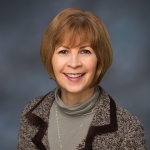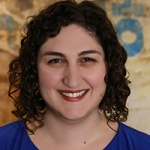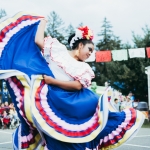Oregon
Oregon
What happens when you stumble upon 30 pounds of colored sand in the art supply closet?
Oregon
A Delicate Balance: The Intersection of In-School and Out-of-School Time
Oregon
The Power of Partnerships in Placemaking
Oregon
Statement on the Passing of Joan Mondale
Oregon
2013 Honoree -
Biography
Eloise Damrosch became executive director of the Regional Arts & Culture Council in Portland, OR, in 2004 after serving as Director of Public Art for 17 years. She continues to lead the Public Art Program and helped RACC launch its successful workplace giving program, tri-county arts education initiative, and had a leadership role in the November 2012 passage of a ballot measure creating the Arts Education and Access Fund which will raise through a modest income tax over $12 million new dollars to restore art and music teachers to every Portland elementary school; strengthen arts
Oregon
State Arts Action Network
Oregon
National Arts Marketing Project

Mr. Paul Kinley
Creative Expression and Workplace Culture
Posted by Nov 29, 2018

Mr. Paul Kinley
Providing constant and protected space for the exchange of ideas is critically important to the health of our business through the active engagement of our employees. All businesses need new ideas, and businesses benefit when the generation of ideas is encouraged and inclusive. To thrive, businesses need to provide a setting where ideas can be openly exchanged and tested. It is the responsibility of business leaders to understand that the work we all do is best done in an environment that’s not based on the ownership of ideas or the rank of those that offer them—but rather one that’s open, collaborative, and receptive to new ways of thinking and doing. Business leaders need to make intentional steps towards creating these spaces. Otherwise, we miss the opportunity to unleash and develop the inherit creative talent of our employees.
Read More
Ms. Danel Malan
Winter Wonderings in Arts Education
Posted by Dec 12, 2018

Ms. Danel Malan
As arts educators, we should always try to dream big. We don’t need a Broadway budget to create good educational theatre. What we need are dedicated arts educators who are passionate about the message of the production and how it can be a transformative experience for young people. So many students often tell us that this may be the first play they have ever seen and how powerful the storytelling experience was for them. Rain, sleet, or snow, like the post office, we always deliver an authentic theatre experience; no matter where we go or how we get there, the rewards are always worth the effort.
Read More
Randy Cohen
Americans Speak Out About the Arts in 2018: An In-Depth Look at Perceptions and Attitudes About the Arts in America
Posted by Sep 27, 2018

Randy Cohen
In a society struggling to find equity and social justice, Americans believe the arts improve the quality of our communities. How do we know? We asked. Americans Speak Out About the Arts in 2018 is the second in a series of national public opinion surveys conducted by Ipsos on behalf of Americans for the Arts. One of the largest ever conducted, it gauges the public perspective on (1) personal engagement in the arts as audience and creator, (2) support for arts education and government arts funding, (3) opinions on the personal and well-being benefits that come from engaging in the arts, and (4) how those personal benefits extend to the community. Here are some findings of the survey.
Read More
Ms. Abby Lynch
Do your part for public art—check out the #KRISArtofGiving campaign
Posted by Sep 19, 2016

Ms. Abby Lynch
KRIS Wines has partnered with Americans for the Arts to celebrate the value of public art in American communities, and reward the artists who create it. They’re giving away $25,000 in prizes to artists who have recently completed projects in the United States, and your votes—up to once per day at kriswine.com/giving—will determine the winners.
Read More
Jenny M. Chu
A.W.E in Portland: Arts Workers for Equity
Posted by May 10, 2018

Jenny M. Chu
I work in the nonprofit arts sector in Portland, Oregon, which is 76% white despite the growing racial and ethnic diversity in the country. This whiteness was deliberately designed. In the 1800s, exclusionary laws were ratified into the Oregon constitution and the language wasn’t officially removed until 2002. This history is reflected in who lives, works, and plays here, including the demographic makeup of who runs our cultural and artistic institutions. In 2016, a group of us arts administrators came together with the evocative question: “Why are the arts so white?” A truly grassroots operation, Arts Workers for Equity (AWE) is a collective of ten individuals who represent a multitude of intersectional identities. Alone and individually, we had limited power to effect change. But collectively we’ve influenced Portland’s nonprofit arts sector, citywide.
Read More
Ms. Danel Malan
Arts Integrated AND Bilingual
Posted by May 02, 2018

Ms. Danel Malan
So many teachers and other artists have asked, “Why bilingual?”, because it was how I wanted to share Latino culture through language, my personal mission as an Artistic Director. Then the old lightbulb exploded and for two years of graduate school I started (and continue) to work on my case study. Working in two counties and several schools, I have set out to quantitatively measure the percentage of higher comprehensive learning from students who have participated in one of our bilingual arts-integrated residencies. It has been exciting research for a data nerd because it is a unique study. I had to piecemeal it together: studies in arts integration, studies in bilingual integration, and all the other forms of both in between—for example, arts-learning does not necessarily imply arts-integrated.
Read More
Ms. Christina Ritchie
Preparing Your Organization and Your Donors for Shifts in the Charitable Tax Deduction
Posted by Feb 16, 2018

Ms. Christina Ritchie
On January 1, the 2018 Tax Cuts & Jobs Act went into effect, a substantial change to the U.S. tax code which has the potential to negatively impact arts and culture nonprofit organizations in a variety of ways. One of the most significant impacts will come in changes related to the thresholds and amounts associated with the charitable tax deduction. This 100-year-old provision was designed to stimulate giving to charities and other organizations serving the public good by providing an opportunity to claim a deduction as a reduction in an individual’s tax burden. While the repercussions of the federal tax code changes are still emerging, and corresponding shifts in state-by-state tax policy may impact your situation, the notes that follow are an introductory primer. If you have questions about state-level implications, we recommend you reach out to your state comptroller or state association of nonprofits.
Read More
Ms. Kate O. McClanahan
Arts Advocacy Day Is Coming
Posted by Feb 01, 2018

Ms. Kate O. McClanahan
Although years may really just be a number, in its 31 years, Arts Advocacy Day has seen six different U.S. presidents spanning both political parties. It’s witnessed sixteen different congressional sessions and eight different Speakers of the U.S. House. Through it all, every year, attendees hear that “the arts are bipARTtisan.” Because, no matter who’s in office, arts advocacy matters. Funding decisions are made every year. Who’s deciding this year may not be deciding next year. Who’s to remember what happened before? Who’s to know why it matters? Who’s to learn from each other? The answer is us. All of us. All of us together.
Read More
Gema Huizar Rios
Ballet Folklorico? Not for me! Or, So I Thought
Posted by Sep 12, 2017

Gema Huizar Rios
Arts education is important because it helps others express themselves into music, art, drawing and many other different forms that people use to show how they feel. It’s important for people to show how they feel so you don’t get depressed and push people away. This only makes you feel lonely and dark inside. For someone who is Mexican American, arts education is very important because it helps me learn about who I am and who my family is. And for me, my family is unique and full of culture.
Read More
Ms. Deb Vaughn
An Interview with Megan Kim: 2017 Oregon State Poetry Out Loud Champion
Posted by Sep 13, 2017

Ms. Deb Vaughn
By bringing poems into high schools, Poetry Out Loud exposes large numbers of students to a wide variety of poetry, and in doing so, opening up their lives to all that it can offer. It encourages community among contestants and builds up confidence in participants, as they learn to identify with the poet’s words and discover the best way to share them with others. It connects at an intensely human level that transcends the words it relies upon.
Read More
Randy Cohen
Arts & Economic Prosperity 5: How the Nonprofit Arts & Culture Industry Impacts the Economy in Your Community
Posted by Jun 17, 2017

Randy Cohen
When recently asked how best to advocate for the arts in the current environment, U.S. Senator Tom Udall (NM)—co-chair of the Senate Cultural Caucus and chief sponsor of the CREATE Act—was unequivocal: “Start by telling every one of your Senators about the economic benefits of the arts.” This familiar refrain is one we have heard for decades from city council chambers to governor mansions to the halls of Congress—and it works. Arts & Economic Prosperity 5 does just that. It changes the conversation about the arts from that of a “charity” to one about an “industry” that provides both cultural and economic benefits to the community.
Read More
Jessica Gaines
8 Times the Arts Saved the Day at Work
Posted by Feb 23, 2017

Jessica Gaines
Whether focusing on employee engagement, customer appreciation, recruiting talent, or fostering community, these eight case studies, taken from a series of essays produced by the pARTnership Movement, showcase how today’s most innovative businesses are using the arts to help meet some of their most difficult and vital objectives.
Read More
Catherine Widgery
Passing Storms Installed at the Oregon State Hospital in Junction City, Oregon
Posted by Aug 15, 2016

Catherine Widgery
“Passing Storms” portrays the changing weather as metaphor for unpredictable and shifting states of mind. As the residents and visitors move through the hospital courtyards, they see the cloud and rain sculptures subtly change depending on the angle of the light and the color of the sky.
Read More
Mr. Jeff A. Hawthorne
Rock for Art
Posted by May 20, 2016

Mr. Jeff A. Hawthorne
Like several other communities that have been posting on the blog this week, we at the Regional Arts & Culture Council (Portland, Oregon) were looking for a fun way to celebrate creativity in business and cultivate employee engagement in the arts while raising more money for our 10th annual united arts fund campaign, known as Work for Art. Drawing from several great models including the CincySings event produced by ArtsWave, we decided to produce a Battle of the Bands on May 12 at the beautiful Crystal Ballroom in downtown Portland.
And what a battle it was! By the end of the night, we had raised about $75,000.
Read More
Ms. Deb Vaughn
Top Ten Challenges to Providing More Arts Education
Posted by Apr 13, 2016

Ms. Deb Vaughn
In mid-2015, the Oregon Community Foundation and the Oregon Arts Commission conducted a survey Oregon to gather information about what kind of arts education was provided by non-profit organizations during the 2014-15 school year. 152 organizations voluntarily responded, and while this self-selected sample may not reflect the work of all nonprofits providing arts education, it does offer interesting insight into the landscape in our state.
Most importantly, the Oregon Arts Education Snapshot confirmed that nonprofit organizations play a robust role in offering arts education opportunities for students.
Read More
Ms. Marna Stalcup
They say only death and taxes are certain. In Portland, Oregon, make room for the arts, too.
Posted by Apr 05, 2016

Ms. Marna Stalcup
How many times have we heard people groan about taxes? Lots.
What if it’s to support arts education in public schools? That was a different story in Portland, Oregon in 2012 when residents said, “YES! We’ll vote for that.” They overwhelmingly endorsed a measure that has restored art and music teachers in all the city’s elementary schools.
Read More
Mr. Ken Busby
The season of Thanksgiving in Arts Education
Posted by Dec 02, 2015

Mr. Ken Busby
It's the season of thanksgiving, and we have so much to be thankful for in a world that may, at times, seem less than hospitable.
This week, we celebrated Giving Tuesday – a reminder that while the Black Friday, Small Business Saturday, and Cyber Monday retail efforts are all important to the economy, the nonprofit world deserves equal consideration in terms of financial support for the good these organizations do in our communities.
Where would we be as a nation without our arts education nonprofit organizations? Where would we be without art and music and dance and drama and poetry and theatre?
Read More
Ms. Stacy Lasner
“C is for...” Creative Messaging Through the Arts
Posted by Nov 19, 2015

Ms. Stacy Lasner
If I ask what “C is for,” many of you reading this would probably respond by recalling the lyrics of Cookie Monster’s famous song. Throughout history, from the cave wall to the Facebook wall, art has forged connections by communicating specific ideas and emotions in a relatable, memorable way. The idea that art can be used not only to entertain, but also to communicate important messages, has been demonstrated effectively by educational children’s television shows. Numerous studies over the years have shown that children who watched Sesame Street programming outperformed their peers in English, math, and science, and had more positive attitudes toward school.
Read More
Michael Blakeslee

Lynn Tuttle
Reauthorization of ESEA and the National Core Arts Standards
Posted by Sep 16, 2015

Michael Blakeslee

Lynn Tuttle
How does the Reauthorization of ESEA connect to the 2014 National Core Arts Standards?
The Senate “Every Child Achieves Act” version of ESEA contains language which is supportive of the intent and the content of the National Core Arts Standards.
1. The Senate bill includes a listing of core academic subjects which funding in the bill can support, including Title I, the largest allocation of education funding at the federal level. The arts and music are listed as core academic subjects in the Senate version of the bill, allowing federal funds to support learning in all the arts (see page 549).
2. The Senate bill includes language which is supportive of states creating rigorous academic content standards in all (core) academic subjects, including the arts and music. The National Core Arts Standards were written with that intent in mind – that states would utilize the new national, voluntary arts education standards to create standards of their own.
Read More
Mr. Jeff A. Hawthorne
Using public funding to incent private sector contributions
Posted by Jun 04, 2015

Mr. Jeff A. Hawthorne
I live in a community that clearly values the arts and creativity – arts participation in Portland and in Oregon is among the highest in the country according to the NEA. Even so, private philanthropy lags significantly behind the national average.
How can we convince more Oregonians to support the arts? Anytime we launch a new private sector initiative, we turn to our government partners first. (Perhaps that’s partially because our local arts agency, the Regional Arts & Culture Council, was a city bureau until 1995.) In any event, public-private partnerships have become the standard way of growing the Portland metro region’s arts community.
Read More
Ms. Deb Vaughn
Academic Rigor through the Arts
Posted by May 20, 2015

Ms. Deb Vaughn
Arts integration has ebbed and flowed in American schools since the 1940’s, in various forms. I read a recent grant proposal that pointed out the challenges of the arts in service of other subjects versus the arts as equal too all subjects. The tension between STEM and STEAM demonstrates ongoing discomfort with integrating subject areas. But intellectual rigor and intense creativity are not mutually exclusive.
Read More









